A Novel Fault Detection and Identification Framework for Rotating Machinery Using Residual Current Spectrum
Abstract
:1. Introduction
- Considers its coupled mechanical or driven system [14];
- Requires prior knowledge regarding the specific operation conditions [13];
- Can be time-consuming, nontrivial, and inaccurate due to the dynamic assumptions, and some of the model uncertainties are not quantifiable [15].
2. Motor Current Signature
2.1. Motor Current Signal Description
2.2. Fault Characteristic Frequency
3. Data-Driven Model Development
3.1. Subspace Identification
3.2. Residual Current Generation
| Algorithm 1 IM state-space identification |
4. Fault Detection and Identification Algorithm
4.1. Residual Current Spectrum Threshold
4.2. Binary Pattern of Fault Signature
4.3. Fault Identification
| Algorithm 2 Fault Detection and Identification |
|
5. Experimental Setup
6. Results and Discussions
6.1. Angular Misalignment
6.2. Turbulent Flow
7. Conclusions and Future Works
7.1. Conclusions
7.2. Future Works
Author Contributions
Funding
Data Availability Statement
Acknowledgments
Conflicts of Interest
Abbreviations
| CT | Current Transformer |
| DAQ | Data Acquisition |
| DFT | Discrete Fourier Transform |
| FDI | Fault Detection and Identification |
| FFT | Fast Fourier Transform |
| IM | Induction Motor |
| MCSA | Motor Current Signature Analysis |
| MFDI | Model-based Fault Detection and Identification |
| Probability Density Function | |
| RM | Rotating Machinery |
| SEE | Standard Error Estimate |
| SID | Subspace Identification |
| SNR | Signal-to-Noise Ratio |
| SVD | Singular Value Decomposition |
References
- Jung, J.H.; Lee, J.J.; Kwon, B.H. Online Diagnosis of Induction Motors Using MCSA. IEEE Trans. Ind. Electron. 2006, 53, 1842–1852. [Google Scholar] [CrossRef]
- Elbouchikhi, E.; Choqueuse, V.; Auger, F.; Benbouzid, M.E.H. Motor Current Signal Analysis Based on a Matched Subspace Detector. IEEE Trans. Instrum. Meas. 2017, 66, 3260–3270. [Google Scholar] [CrossRef] [Green Version]
- Zafarani, M.; Jafari, B.H.; Akin, B. Lateral and Torsional Vibration Monitoring of Multistack Rotor Induction Motors. IEEE Trans. Ind. Electron. 2021, 68, 3494–3505. [Google Scholar] [CrossRef]
- Trajin, B.; Regnier, J.; Faucher, J. Comparison Between Vibration and Stator Current Analysis for the Detection of Bearing Faults in Asynchronous Drives. IET Electr. Power Appl. 2010, 4, 90–100. [Google Scholar] [CrossRef] [Green Version]
- Hwang, I.; Kim, S.; Kim, Y.; Seah, C.E. A Survey of Fault Detection, Isolation, and Reconfiguration Methods. IEEE Trans. Control Syst. Technol. 2010, 18, 636–653. [Google Scholar] [CrossRef]
- Wang, Y.; Ma, G.; Ding, S.X.; Li, C. Subspace Aided Data-Driven Design of Robust Fault Detection and Isolation Systems. Automatica 2011, 47, 2474–2480. [Google Scholar] [CrossRef]
- Dai, X.; Gao, Z. From Model, Signal to Knowledge: A Data-Driven Perspective of Fault Detection and Diagnosis. IEEE Trans. Ind. Inform. 2013, 9, 2226–2238. [Google Scholar] [CrossRef] [Green Version]
- Chen, J.; Yang, F. Data-Driven Subspace-based Adaptive Fault Detection for Solar Power Generation Systems. IET Control Theory Appl. 2013, 7, 1498–1508. [Google Scholar] [CrossRef]
- Angelo, C.D.; Bossio, G.; Giaccone, S.; Valla, M.; Solsona, J.; Garcia, G. Online Model-Based Stator-Fault Detection and Identification in Induction Motors. IEEE Trans. Ind. Electron. 2009, 56, 4671–4680. [Google Scholar] [CrossRef]
- Duan, F.; Zivanovic, R. Condition Monitoring of an Induction Motor Stator Windings Via Global Optimization Based on the Hyperbolic Cross Points. IEEE Trans. Ind. Electron. 2015, 62, 1826–1834. [Google Scholar] [CrossRef]
- Duan, F.; Živanović, R. Induction Motor Stator Fault Detection by a Condition Monitoring Scheme Based on Parameter Estimation Algorithms. Electr. Power Componen. Syst. 2016, 44, 1138–1148. [Google Scholar] [CrossRef] [Green Version]
- Karami, F.; Poshtan, J.; Poshtan, M. Detection of Broken Rotor Bars in Induction Motors using Nonlinear Kalman Filters. ISA Trans. 2010, 49, 189–195. [Google Scholar] [CrossRef]
- Abid, A.; Khan, M.T.; Lang, H.; de Silva, C.W. Adaptive System Identification and Severity Index-Based Fault Diagnosis in Motors. IEEE/ASME Trans. Mechatron. 2019, 24, 1628–1639. [Google Scholar] [CrossRef]
- Kallesoe, C.; Cocquempot, V.; Izadi-Zamanabadi, R. Model based Fault Detection in a Centrifugal Pump Application. IEEE Trans. Control Syst. Technol. 2006, 14, 204–215. [Google Scholar] [CrossRef]
- Tidriri, K.; Chatti, N.; Verron, S.; Tiplica, T. Bridging Data-Driven and Model-based Approaches for Process Fault Diagnosis and Health Monitoring: A Review of Researches and Future Challenges. Annu. Rev. Control 2016, 42, 63–81. [Google Scholar] [CrossRef]
- Schubert, U.; Kruger, U.; Arellano-Garcia, H.; de Sá Feital, T.; Wozny, G. Unified Model-based Fault Diagnosis for Three Industrial Application Studies. Control Eng. Pract. 2011, 19, 479–490. [Google Scholar] [CrossRef]
- Tariq, M.F.; Khan, A.Q.; Abid, M.; Mustafa, G. Data-Driven Robust Fault Detection and Isolation of Three-Phase Induction Motor. IEEE Trans. Ind. Electron. 2019, 66, 4707–4715. [Google Scholar] [CrossRef]
- Li, Y.; Yang, J.; Liu, W.L.; Liao, C.L. Multi-Level Model Reduction and Data-Driven Identification of the Lithium-Ion Battery. Energies 2020, 13, 3791. [Google Scholar] [CrossRef]
- De Cock, K.; Peeters, B.; Vecchio, A.; Van der Auweraer, H.; De Moor, B. Subspace System Identification for Mechanical Engineering. In Proceedings of the International Conference on Noise and Vibration Engineering (ISMA 2002), Leuven, Belgium, 16–18 September 2002. [Google Scholar]
- Qin, S.J. An Overview of Subspace Identification. Comput. Chem. Eng. 2006, 30, 1502–1513. [Google Scholar] [CrossRef]
- Overschee, P.V.; Moor, B.D. N4SID: Subspace Algorithms for the Identification of Combined Deterministic-Stochastic Systems. Automatica 1994, 30, 75–93. [Google Scholar] [CrossRef]
- Wolkiewicz, M.; Tarchala, G.; Orlowska-Kowalska, T.; Kowalski, C.T. Online Stator Interturn Short Circuits Monitoring in the DFOC Induction-Motor Drive. IEEE Trans. Ind. Electron. 2016, 63, 2517–2528. [Google Scholar] [CrossRef]
- Singh, S.; Kumar, N. Detection of Bearing Faults in Mechanical Systems Using Stator Current Monitoring. IEEE Trans. Ind. Inform. 2017, 13, 1341–1349. [Google Scholar] [CrossRef]
- Luong, P.; Wang, W. Smart Sensor-Based Synergistic Analysis for Rotor Bar Fault Detection of Induction Motors. IEEE/ASME Trans. Mechatron. 2020, 25, 1067–1075. [Google Scholar] [CrossRef]
- Park, Y.; Choi, H.; Shin, J.; Park, J.; Lee, S.B.; Jo, H. Airgap Flux Based Detection and Classification of Induction Motor Rotor and Load Defects During the Starting Transient. IEEE Trans. Ind. Electron. 2020, 67, 10075–10084. [Google Scholar] [CrossRef]
- Jung, J.; Lee, S.B.; Lim, C.; Cho, C.H.; Kim, K. Electrical Monitoring of Mechanical Looseness for Induction Motors With Sleeve Bearings. IEEE Trans. Energy Convers. 2016, 31, 1377–1386. [Google Scholar] [CrossRef]
- Nandi, S. Detection of Stator Faults in Induction Machines Using Residual Saturation Harmonics. IEEE Trans. Ind. Appl. 2006, 42, 1201–1208. [Google Scholar] [CrossRef]
- Wang, B.; Wang, J.; Griffo, A.; Sen, B. Stator Turn Fault Detection by Second Harmonic in Instantaneous Power for a Triple-Redundant Fault-Tolerant PM Drive. IEEE Trans. Ind. Electron. 2018, 65, 7279–7289. [Google Scholar] [CrossRef] [Green Version]
- Oppenheim, A.V. Discrete-Time Signal Processing; Pearson Education India: Delhi, India, 1999. [Google Scholar]
- Nandi, S.; Toliyat, H.; Li, X. Condition Monitoring and Fault Diagnosis of Electrical Motors—A Review. IEEE Trans. Energy Convers. 2005, 20, 719–729. [Google Scholar] [CrossRef]
- Hernandez-Solis, A.; Carlsson, F. Diagnosis of Submersible Centrifugal Pumps: A Motor Current and Power Signature Approaches. EPE J. 2010, 20, 58–64. [Google Scholar] [CrossRef]
- Moor, B.D.; Overschee, P.V.; Favoreel, W. Algorithms for Subspace State-Space System Identification: An Overview. Appl. Comput. Control Signals Circuits 1999, 247–311. [Google Scholar] [CrossRef]
- Van Overschee, P.; De Moor, B. Subspace Identification for Linear Systems: Theory-Implementation-Applications; Kluwer Academic: Dordrecht, The Netherlands, 1996. [Google Scholar]
- Choi, S.; Pazouki, E.; Baek, J.; Bahrami, H.R. Iterative Condition Monitoring and Fault Diagnosis Scheme of Electric Motor for Harsh Industrial Application. IEEE Trans. Ind. Electron. 2015, 62, 1760–1769. [Google Scholar] [CrossRef]
- Choi, S.; Akin, B.; Rahimian, M.M.; Toliyat, H.A. Implementation of a Fault-Diagnosis Algorithm for Induction Machines Based on Advanced Digital-Signal-Processing Techniques. IEEE Trans. Ind. Electron. 2011, 58, 937–948. [Google Scholar] [CrossRef]
- Berry, J.E. Analysis II: Concentrated Vibration Signature Analysis and Related Condition Monitoring Techniques; Technical Report; Technical Associates of Charlotte PC: Charlotte, NC, USA, 1997. [Google Scholar]

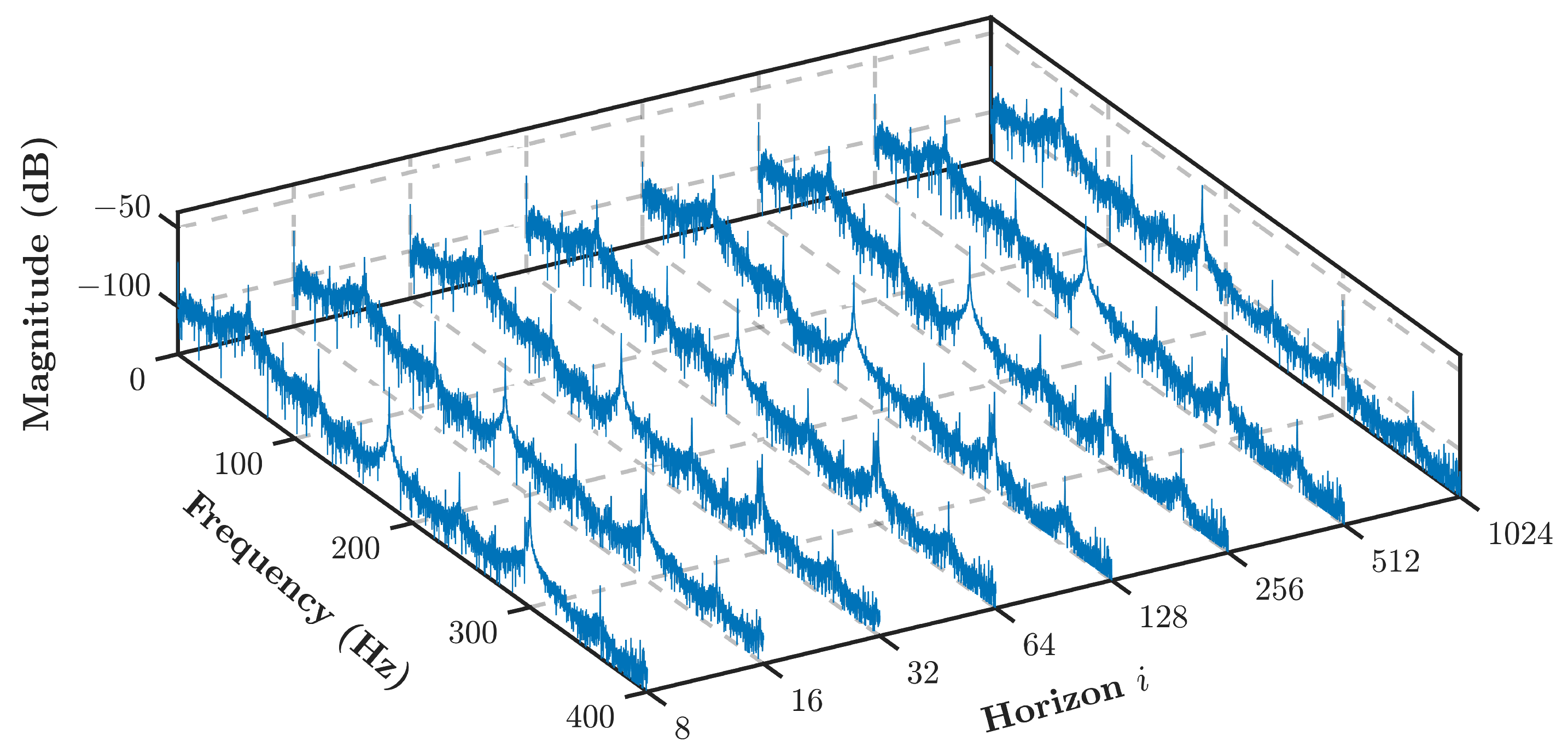







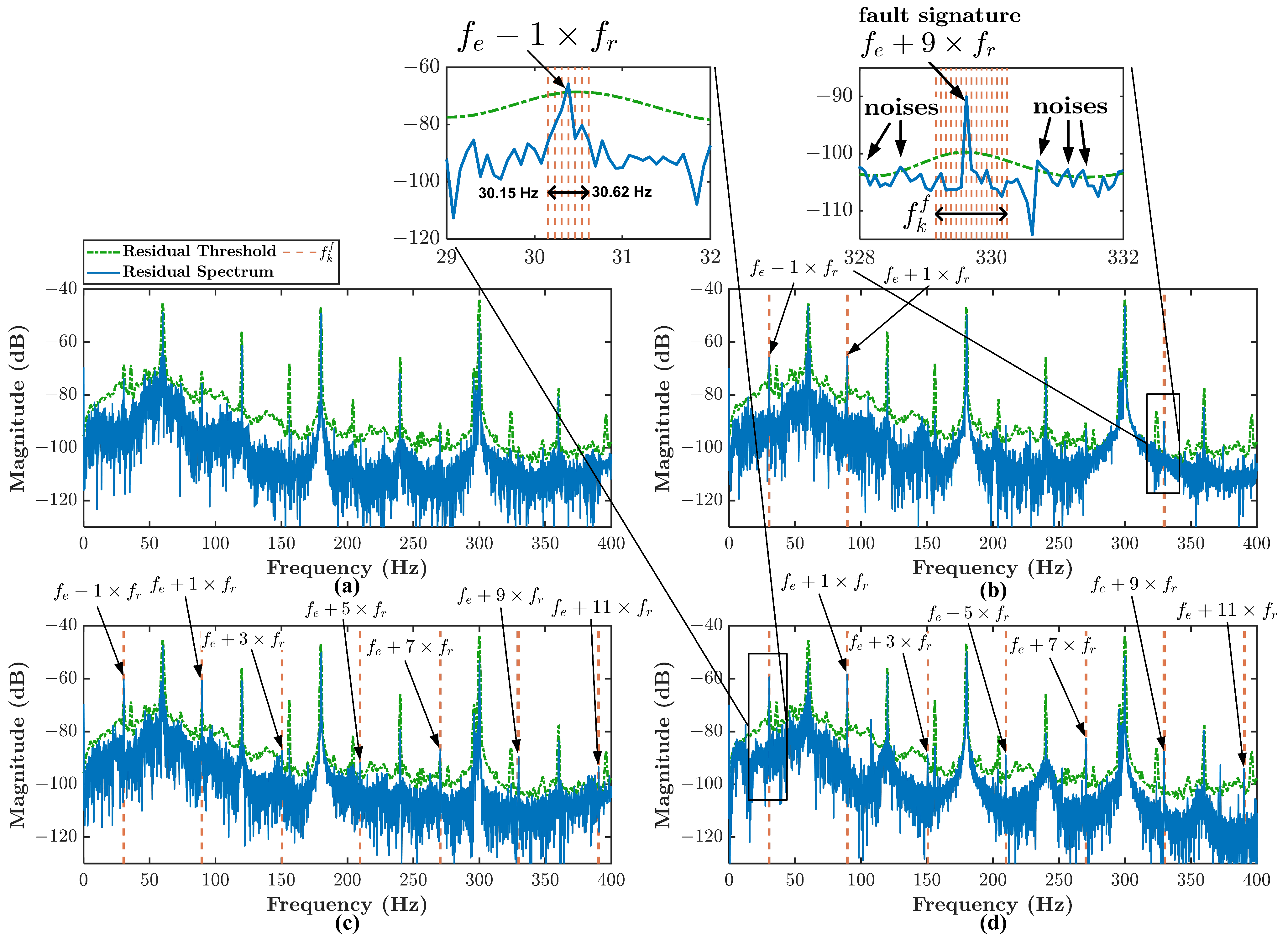

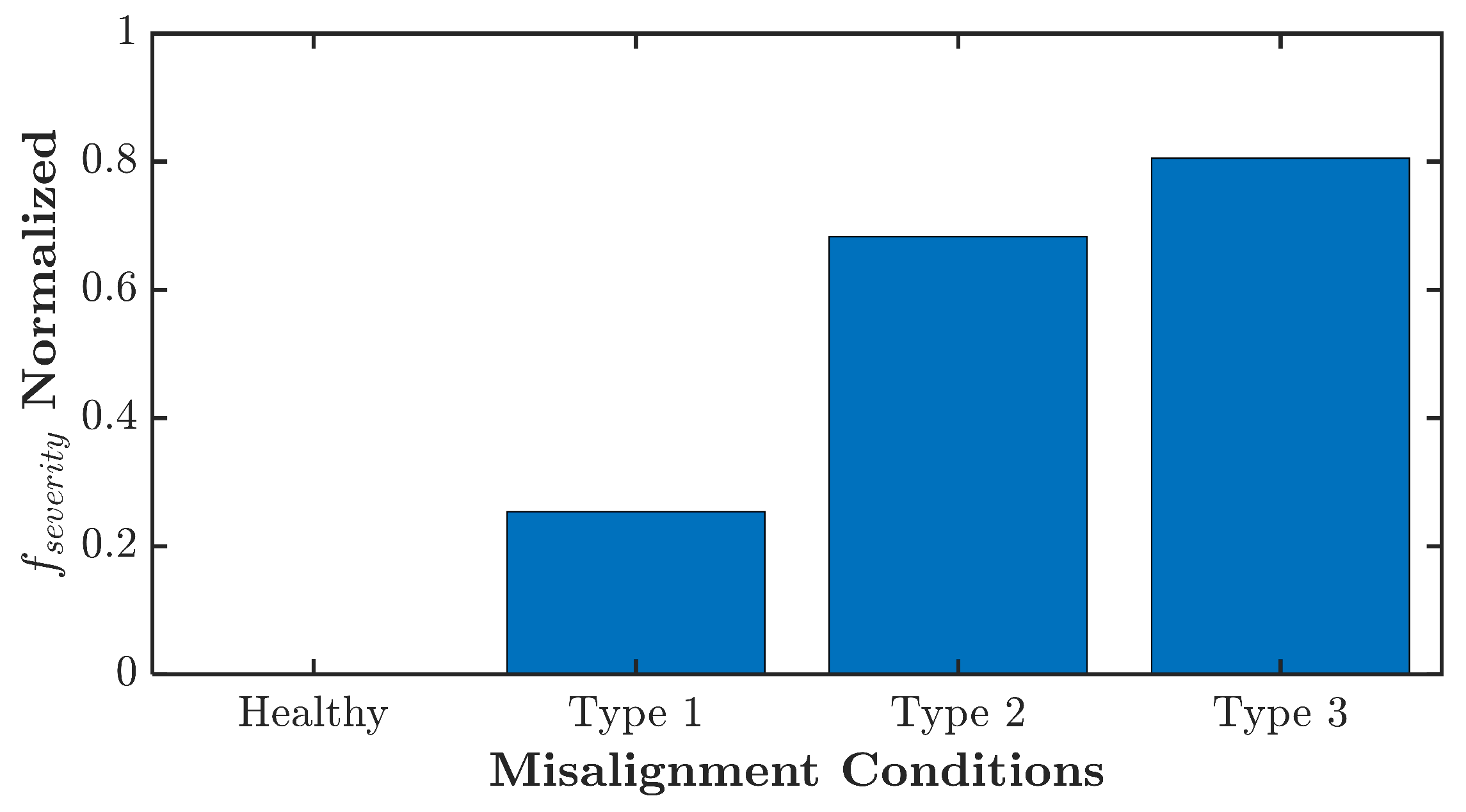
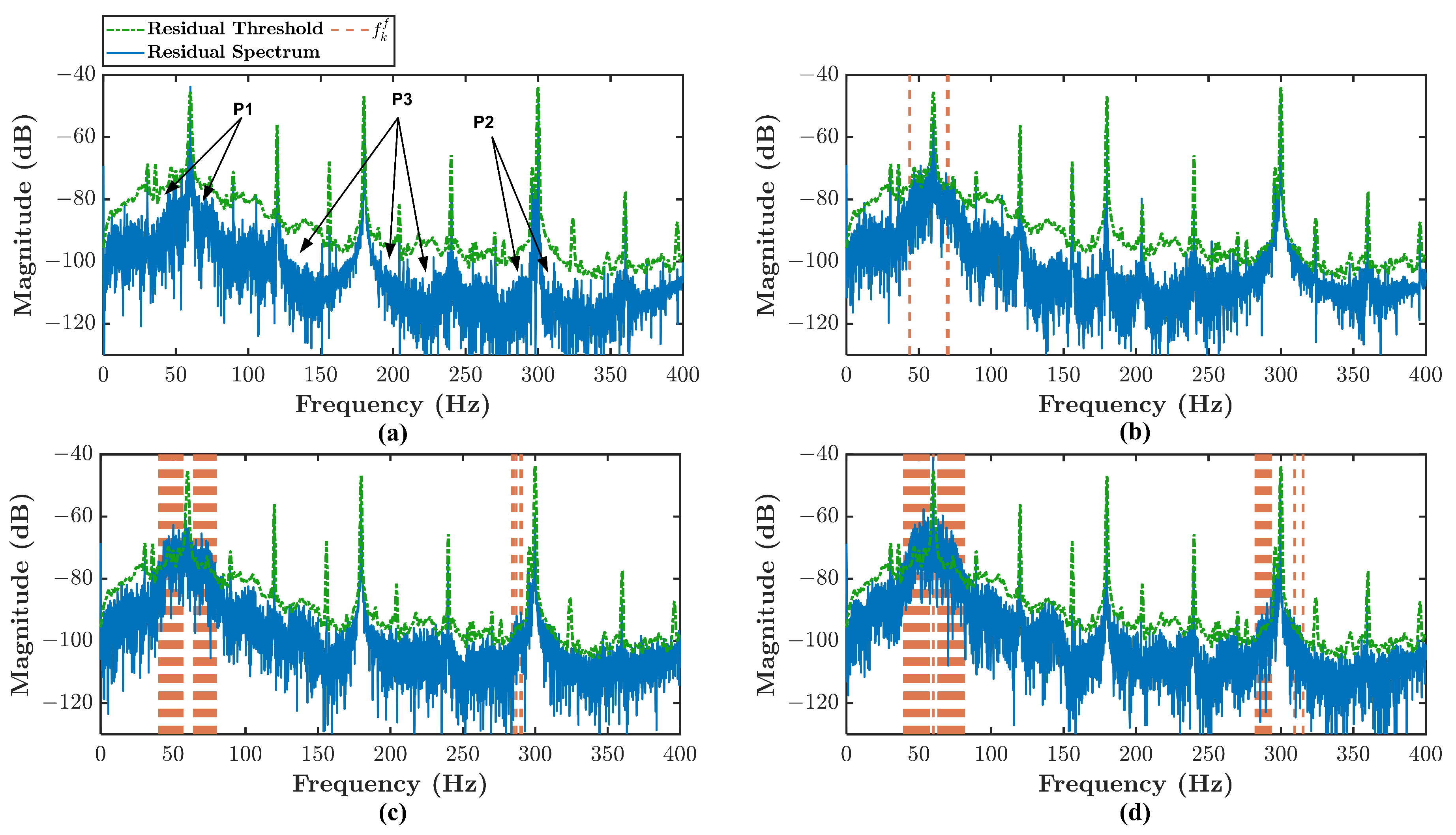
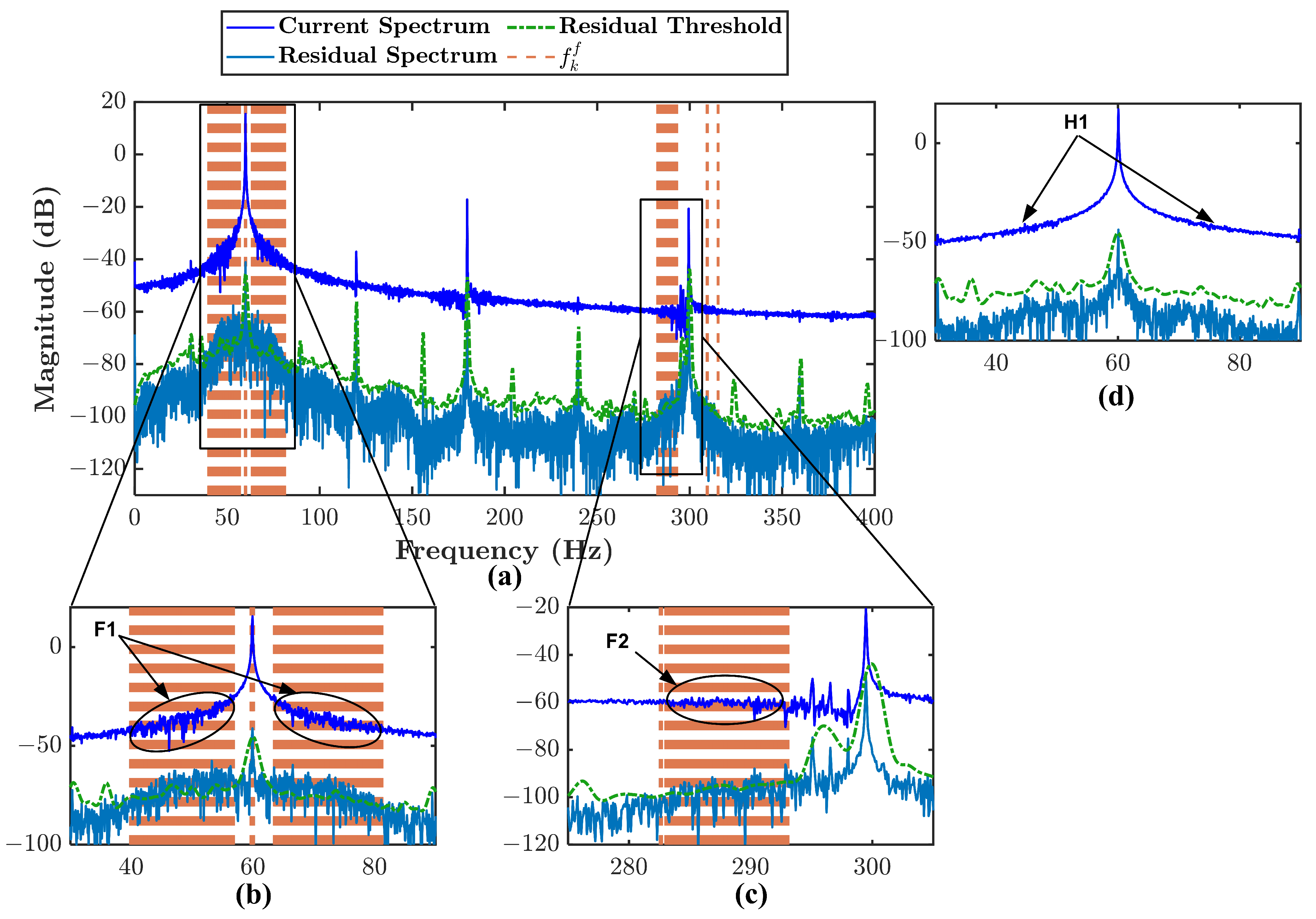

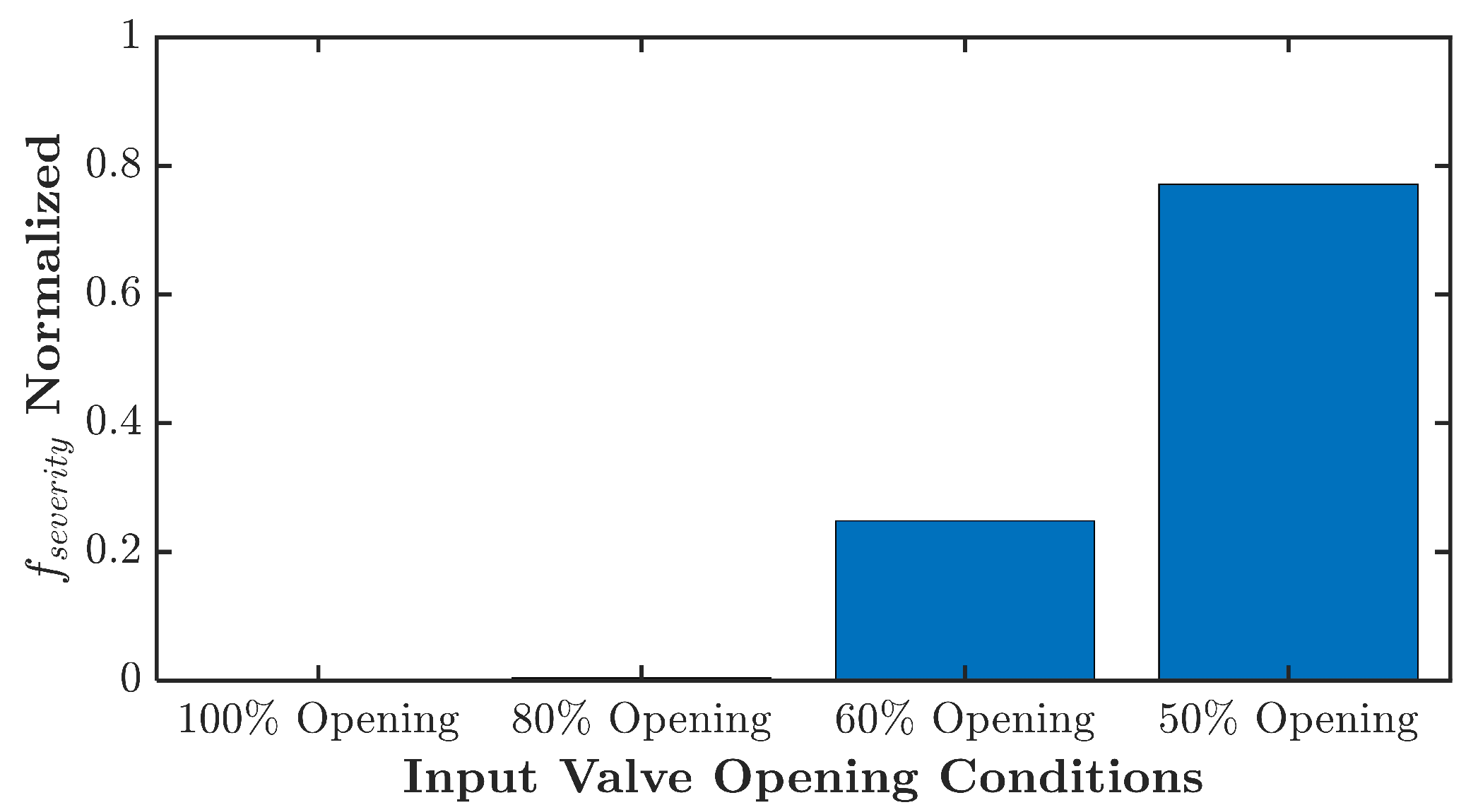
| Horizon i | Time (s) | SEE (%) |
|---|---|---|
| 8 | 0.05 | 1.75 |
| 16 | 0.09 | 1.59 |
| 32 | 0.19 | 1.12 |
| 64 | 0.51 | 1.41 |
| 128 | 1.20 | 1.41 |
| 256 | 3.11 | 1.49 |
| 512 | 15.01 | 1.45 |
| 1028 | 90.97 | 1.55 |
| Parameters | Value | Unit |
|---|---|---|
| Phase | 3 | - |
| Poles | 4 | - |
| Power | 17 | kW |
| Frequency | 60 | Hz |
| Rated Current | 17 | A |
| Rated Voltage | 480 | V |
| Rated Speed | 1760 | rpm |
| Parameters | Value | Unit |
|---|---|---|
| 0.6 | - | |
| 0.4 | - | |
| M (index) | 3 | indices |
| 0.5 | - |
| Identified Fault Frequencies | |||||||||||
|---|---|---|---|---|---|---|---|---|---|---|---|
| Fault Signature | Frequency (Hz) | 1 | 2 | 3 | 4 | 5 | |||||
| 30.35 | 30.39 | 396 | 30.46 | 397 | 30.31 | 395 | 30.31 | 395 | 30.39 | 396 | |
| 89.65 | 89.69 | 1167 | 89.77 | 1168 | 89.62 | 1166 | 89.54 | 1165 | 89.62 | 1166 | |
| 148.95 | 150.39 | 1956 | 150.62 | 1959 | 150.31 | 1955 | 150.23 | 1954 | 150.31 | 1955 | |
| 208.25 | 209.7 | 2727 | 210 | 2731 | 209.54 | 2725 | 209.46 | 2724 | 209.54 | 2725 | |
| 267.55 | 270.47 | 3517 | 270.85 | 3522 | 270.23 | 3514 | 270.16 | 3513 | 270.23 | 3514 | |
| 326.85 | 329.78 | 4288 | 330.24 | 4294 | 329.47 | 4284 | 329.39 | 4283 | 329.47 | 4284 | |
| 386.15 | 390.47 | 5077 | 391.08 | 5085 | 390.16 | 5073 | 390.01 | 5071 | 390.16 | 5073 | |
Publisher’s Note: MDPI stays neutral with regard to jurisdictional claims in published maps and institutional affiliations. |
© 2021 by the authors. Licensee MDPI, Basel, Switzerland. This article is an open access article distributed under the terms and conditions of the Creative Commons Attribution (CC BY) license (https://creativecommons.org/licenses/by/4.0/).
Share and Cite
Purbowaskito, W.; Lan, C.-Y.; Fuh, K. A Novel Fault Detection and Identification Framework for Rotating Machinery Using Residual Current Spectrum. Sensors 2021, 21, 5865. https://doi.org/10.3390/s21175865
Purbowaskito W, Lan C-Y, Fuh K. A Novel Fault Detection and Identification Framework for Rotating Machinery Using Residual Current Spectrum. Sensors. 2021; 21(17):5865. https://doi.org/10.3390/s21175865
Chicago/Turabian StylePurbowaskito, Widagdo, Chen-Yang Lan, and Kenny Fuh. 2021. "A Novel Fault Detection and Identification Framework for Rotating Machinery Using Residual Current Spectrum" Sensors 21, no. 17: 5865. https://doi.org/10.3390/s21175865







